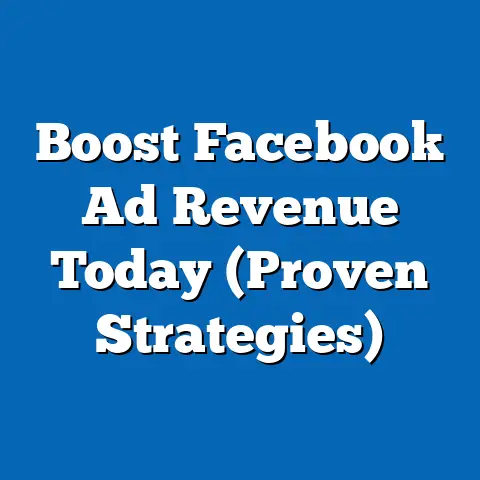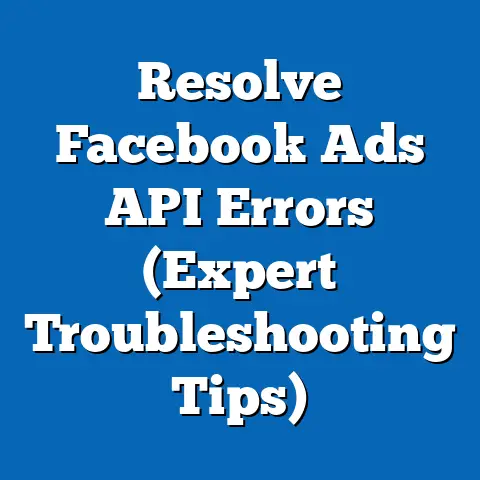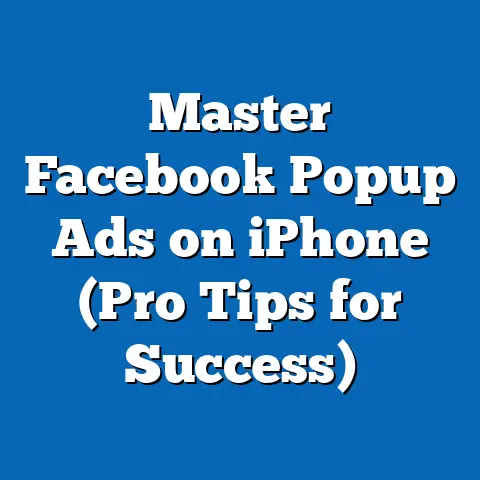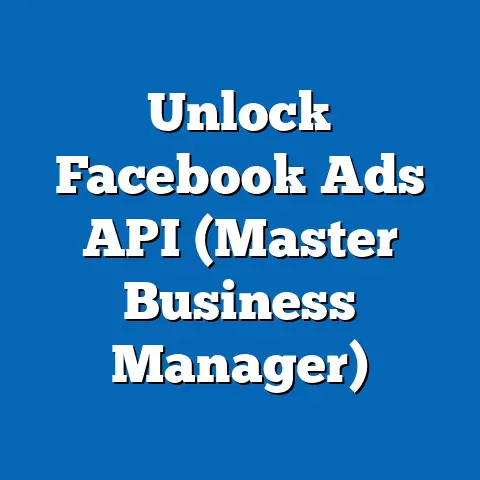Mastering Facebook Live Ads (Expert Tips for Engagement)
Investment in digital advertising has become a cornerstone of modern marketing strategies, reflecting the profound shift in how businesses connect with consumers in an increasingly digital world. As traditional advertising channels like print and television lose ground to online platforms, companies are allocating significant portions of their budgets—often upwards of 50% in some industries—to digital spaces. This investment is not merely financial; it also represents a commitment to understanding consumer behavior, leveraging technology, and adapting to rapid societal changes.
The rise of digital advertising investment can be traced back to the early 2000s, with the advent of search engine marketing and banner ads. However, the introduction of social media platforms like Facebook in 2004 revolutionized the landscape, offering unprecedented opportunities for targeted, interactive advertising. Today, platforms like Facebook, with over 2.9 billion monthly active users as of 2023 (Statista), serve as critical arenas for brands to engage with diverse audiences, making investment in such platforms a strategic imperative.
Societally, this investment has far-reaching implications. It has democratized marketing by allowing small businesses to compete with larger corporations through cost-effective tools like Facebook Ads. However, it also raises concerns about data privacy, consumer manipulation, and the digital divide, as not all demographics have equal access to or familiarity with these technologies. This article will explore the nuances of investing in digital advertising, with a specific focus on mastering Facebook Live Ads—a dynamic format that prioritizes real-time engagement.
Generational Context of Digital Advertising Investment
To fully understand the investment in digital advertising, it is essential to consider the generational dynamics that shape both the creators and consumers of these campaigns. Different generations have unique relationships with technology, influencing how businesses allocate their advertising budgets and design their strategies.
Baby Boomers (Born 1946-1964)
Baby Boomers, shaped by post-World War II economic prosperity and the rise of television, were the first generation to experience mass marketing on a large scale. While they are not digital natives, many have adapted to online platforms, with 68% of Boomers using Facebook as of 2021 (Pew Research Center). However, their engagement with digital ads often prioritizes trust and familiarity, making them less responsive to experimental formats like Live Ads unless tied to established brands.
Generation X (Born 1965-1980)
Generation X, often considered the “bridge” generation, grew up during the transition from analog to digital technologies. They witnessed the birth of the internet and are comfortable with social media, with 77% using Facebook (Pew Research Center). For advertisers, Gen X represents a pragmatic audience that values authenticity and utility in digital content, including live formats that offer real-time problem-solving or demonstrations.
Millennials (Born 1981-1996)
Millennials, the first true digital natives, came of age alongside the internet and social media. With 84% active on Facebook, they are a primary target for digital advertising due to their purchasing power and tech-savviness. Millennials are drawn to interactive, authentic content, making Facebook Live Ads particularly effective for this group when they feature influencer collaborations or behind-the-scenes looks at brands.
Generation Z (Born 1997-2012)
Generation Z, born into a world of smartphones and social media, approaches digital content with a critical eye, valuing transparency and immediacy. With 70% using platforms like Facebook alongside newer apps like TikTok (Statista, 2023), they are highly responsive to live content that feels unscripted and community-driven. For advertisers, investing in Live Ads for Gen Z means prioritizing trends, humor, and social causes.
Societal Implications of Generational Dynamics
The generational diversity in digital advertising investment highlights the need for tailored strategies that respect varying levels of tech adoption and cultural values. While younger generations drive innovation in formats like Facebook Live, older generations ensure a broad market reach, necessitating a balanced investment approach. This diversity also underscores broader societal shifts toward personalization and interactivity in marketing, challenging businesses to innovate while maintaining inclusivity.
Historical Context of Digital Advertising and Live Streaming
The evolution of digital advertising investment is deeply tied to technological advancements and economic shifts over the past two decades. In the late 1990s and early 2000s, the dot-com boom spurred initial investments in online banner ads and email marketing, though these were often static and lacked engagement. The launch of Google AdWords in 2000 introduced a data-driven, pay-per-click model that revolutionized how businesses measured return on investment (ROI).
Social media’s emergence in the mid-2000s marked a turning point, with Facebook introducing its advertising platform in 2007. This allowed for hyper-targeted campaigns based on user demographics, interests, and behaviors—a stark contrast to the broad, untargeted ads of earlier internet eras. The 2016 introduction of Facebook Live further transformed the landscape by combining real-time video with advertising capabilities, capitalizing on the growing consumer preference for video content, which now accounts for 82% of internet traffic (Cisco, 2022).
Economically, the 2008 financial crisis pushed businesses toward cost-effective digital channels over expensive traditional media, accelerating investment in platforms like Facebook. Culturally, the rise of influencer marketing and user-generated content in the 2010s aligned with the capabilities of live streaming, making formats like Facebook Live Ads a natural progression for brands seeking authenticity and immediacy. Today, investment in live streaming ads is not just a trend but a strategic response to a digital-first world shaped by connectivity and instant gratification.
Why Invest in Facebook Live Ads?
Facebook Live Ads represent a unique opportunity for businesses to engage audiences in real time, fostering a sense of connection that static ads cannot replicate. Unlike pre-recorded content, Live Ads allow for immediate interaction through comments, reactions, and shares, with studies showing that live videos on Facebook generate 6 times more interactions than regular videos (Facebook Insights, 2022). This interactivity translates to higher engagement rates, often ranging from 4-6% compared to 1-2% for traditional ads (Social Media Today, 2023).
Investment in Live Ads also offers cost efficiency, as they can be produced with minimal equipment—a smartphone and a stable internet connection often suffice. For small businesses, this democratizes access to high-impact advertising, while larger brands can scale productions with professional setups. Additionally, Facebook’s robust targeting tools ensure that Live Ads reach the right audience, maximizing ROI through precise demographic and behavioral filters.
However, the investment is not without risks. Live formats are unpredictable; technical glitches or unscripted mishaps can damage brand reputation if not managed well. Moreover, audience fatigue is a concern, as oversaturation of live content can reduce impact—marketers must balance frequency with value. Despite these challenges, the potential for authentic engagement makes Facebook Live Ads a worthy investment for brands willing to innovate.
Expert Tips for Mastering Facebook Live Ads Engagement
Creating successful Facebook Live Ads requires a strategic blend of creativity, technical know-how, and audience understanding. Below are expert-backed tips to maximize engagement and ensure a strong return on investment, drawing from industry best practices and case studies.
1. Pre-Launch Planning: Build Anticipation
Engagement begins before the live stream starts. Promote the event days or weeks in advance using teaser posts, countdowns, and event pages on Facebook to build excitement. According to Hootsuite (2023), pre-promoted live streams see 30% higher viewership in the first 5 minutes, a critical window for capturing attention.
Clearly communicate the value of the Live Ad—whether it’s a product launch, Q&A session, or exclusive discount—and target specific audience segments using Facebook’s ad manager. For instance, a beauty brand might target Millennials and Gen Z with promises of live makeup tutorials, while a financial service could appeal to Gen X with retirement planning tips. Pre-launch planning ensures a strong start, setting the tone for active participation.
2. Optimize Technical Setup for Seamless Delivery
Technical quality is non-negotiable for maintaining viewer trust during a Live Ad. Invest in reliable equipment, such as a high-quality camera or smartphone with a stabilizer, good lighting, and a strong internet connection to avoid buffering—67% of viewers abandon live streams due to poor quality (Livestream, 2022). Test the setup beforehand, ensuring audio clarity and visual appeal.
Additionally, use Facebook’s Creator Studio to schedule and monitor the stream, allowing for real-time analytics on viewer drop-off and engagement. Brands like Nike have mastered this by delivering polished Live Ads during product launches, maintaining viewer retention through crisp visuals and clear sound. A seamless delivery builds credibility and keeps audiences engaged longer.
3. Craft Compelling, Interactive Content
Content is king, even in live formats. Start with a strong hook within the first 10 seconds—pose a question, share a surprising statistic, or offer a sneak peek—to prevent early drop-offs, as 20% of viewers leave within the first minute if uninterested (Wistia, 2023). Structure the Live Ad with a clear agenda, balancing promotional messaging with value-driven content like tutorials, behind-the-scenes looks, or live demos.
Interactivity is key to engagement. Encourage viewers to comment with questions or feedback, and respond in real time to foster a two-way conversation—brands that actively reply during live streams see 50% higher engagement rates (Social Insider, 2022). For example, during a Live Ad for a cooking appliance, a brand might ask viewers to suggest recipes, instantly creating a sense of community.
4. Leverage Influencers and Collaborations
Partnering with influencers during Facebook Live Ads can significantly boost reach and credibility, especially for younger audiences like Millennials and Gen Z, who trust peer recommendations over traditional ads (Nielsen, 2021). Choose influencers whose followers align with your target demographic, ensuring authenticity in the partnership. A fitness brand, for instance, might collaborate with a popular trainer for a live workout session, blending promotion with genuine value.
Collaborations also extend to cross-promotions with complementary brands, amplifying exposure. During the Live Ad, feature giveaways or exclusive codes tied to the influencer’s endorsement to drive immediate action. This strategy not only enhances engagement but also builds long-term brand loyalty through trusted voices.
5. Incorporate Real-Time Calls to Action (CTAs)
Live Ads thrive on immediacy, making real-time CTAs essential for converting engagement into action. Prompt viewers to shop a product, sign up for a newsletter, or participate in a poll during the stream, using clear, urgent language like “Shop now for 20% off—offer ends in 10 minutes!” Data shows that live streams with CTAs see a 25% higher conversion rate compared to those without (HubSpot, 2023).
Display CTAs visually through on-screen graphics or pinned comments, ensuring accessibility for all viewers. For example, during a Live Ad for a fashion brand, overlay a clickable link to the product page while verbally encouraging purchases. Timing these prompts strategically—midway and at the end of the stream—maximizes impact without overwhelming the audience.
6. Analyze and Repurpose Post-Live Content
The value of a Facebook Live Ad extends beyond the broadcast itself. Use Facebook Insights to analyze metrics like peak viewership, engagement rate, and audience retention to understand what worked and what didn’t. For instance, if data shows a drop-off after 15 minutes, future streams can be shortened or restructured for better pacing.
Repurpose the live video into shorter clips or highlights for use in future ads, social posts, or email campaigns, extending the content’s lifecycle. Brands like Sephora often edit Live Ad tutorials into bite-sized Instagram Reels, reaching audiences who missed the original stream. This post-live strategy ensures sustained ROI from the initial investment.
Societal and Cultural Implications of Facebook Live Ads
The growing investment in Facebook Live Ads reflects broader societal shifts toward immediacy and authenticity in digital interactions. Consumers today, particularly younger generations, crave transparency from brands, favoring unpolished, real-time content over overly curated ads. This trend aligns with cultural movements like the “authenticity economy,” where trust is a currency, and live formats offer a window into a brand’s true personality.
Economically, Live Ads contribute to the gig economy by empowering creators and small businesses to reach global audiences without traditional gatekeepers. However, they also exacerbate digital inequities, as success often depends on access to technology and digital literacy, potentially marginalizing certain demographics. Additionally, the interactive nature of Live Ads raises ethical questions about data collection and real-time behavioral targeting, necessitating stricter privacy regulations.
In the workplace, mastery of Live Ads is reshaping marketing roles, requiring professionals to develop skills in video production, audience engagement, and crisis management for live scenarios. Companies must invest in training to keep pace, while also fostering a culture of adaptability to new formats. These implications highlight the dual nature of Live Ads as both an opportunity and a challenge for modern society.
Challenges and Nuances in Engagement Strategies
While Facebook Live Ads offer immense potential, they are not without hurdles. One major challenge is audience fragmentation—different generations and demographics engage differently, requiring nuanced approaches that can strain resources. For instance, while Gen Z might respond to fast-paced, trend-driven content, Baby Boomers may need slower, trust-building narratives, complicating content creation.
Another nuance is the risk of over-engagement, where excessive interaction during a live stream can derail the intended message. Moderating comments and maintaining focus require skilled hosts, an investment that smaller brands may struggle to afford. Additionally, cultural differences in humor, language, and values must be considered to avoid alienating global audiences during live, unscripted moments.
Quantitative data also reveals variability in success rates. While some studies report engagement rates as high as 6% for Live Ads, others note that poorly executed streams can yield less than 1% (eMarketer, 2023). This inconsistency underscores the importance of strategy over mere adoption, urging brands to prioritize quality and relevance over frequency.
Forward-Looking Insights: The Future of Facebook Live Ads
As technology evolves, so too will the landscape of Facebook Live Ads, presenting both opportunities and uncertainties. Advances in augmented reality (AR) and virtual reality (VR) could integrate with live streaming, allowing for immersive ad experiences—imagine a Live Ad where viewers virtually “try on” products in real time. Such innovations could redefine engagement, though they may widen the digital divide if access remains unequal.
Artificial intelligence (AI) will also play a larger role, from personalizing Live Ad content to automating real-time responses to viewer comments. However, over-reliance on AI risks diminishing the human connection that makes live formats unique, a balance brands must navigate. Additionally, as privacy concerns grow, platforms like Facebook may face stricter regulations, potentially limiting targeting capabilities and reshaping investment strategies.
Economically, the continued rise of e-commerce integration within live streams—known as “live shopping”—is poised to drive significant revenue, with projections estimating a $25 billion market by 2025 in the U.S. alone (McKinsey, 2023). This trend, already popular in markets like China, suggests that Live Ads will become a primary sales channel, blurring the lines between entertainment and commerce.
Yet, uncertainties remain. Will audience fatigue set in as more brands adopt live formats, diluting their novelty? How will generational shifts—such as Gen Alpha’s entry into the consumer market—affect content preferences? These questions highlight the need for ongoing research and adaptability, ensuring that investment in Facebook Live Ads remains strategic rather than reactive.
Conclusion
Investment in digital advertising, particularly in innovative formats like Facebook Live Ads, represents a transformative shift in how brands engage with diverse, generational audiences. By understanding the historical context—from the early days of internet ads to the real-time capabilities of today—businesses can appreciate the strategic importance of this medium. The societal implications, from democratizing marketing to raising ethical concerns, underscore the broader impact of such investments on culture and economy.
Mastering Facebook Live Ads requires a blend of pre-planning, technical precision, compelling content, and post-event analysis, as outlined in the expert tips provided. While challenges like audience fragmentation and cultural nuances persist, the potential for authentic, immediate engagement makes this format a powerful tool for modern marketers. Looking ahead, technological advancements and evolving consumer behaviors will shape the future of Live Ads, offering exciting possibilities tempered by uncertainties.
Ultimately, success lies in a balanced approach—leveraging data-driven insights while preserving the human connection at the heart of live streaming. As brands navigate this dynamic landscape, their ability to adapt and innovate will determine whether their investment in Facebook Live Ads yields lasting engagement and impact.





